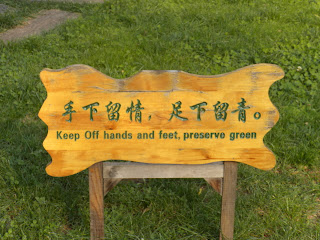A couple of years ago* I posted some comments about the need to have highly qualified people translating Chinese medical texts into English. Translation is difficult even for the most experienced.
Mo Yan, the 2012 Nobel Prize winner for literature recently addressed a reception at the Chinese Embassy in Stockholm on December 7 during his tour to the Swedish capital to receive his prize. He said "I think translation is much harder than writing: It only took me 42 days to write Life and Death Are Wearing Me Out, while it took Swedish sinologist Anna Gustafsson Chen six years to translate the work." (Source: Beijing Review, December 20, 2012).
* see: http://theriverlands.blogspot.com/2010/02/translating-acupuncture-texts.html
Monday, December 24, 2012
Sunday, December 23, 2012
Chinese Idioms, English Idioms
I found a Chinese counterpart to the English saying "You can't teach an old dog new tricks" and I like it better.
It is: 活到老学到老 (huo2 dao4 lao3, xue2 dao4 lao3*) "One is never too old to learn".
It is much more positive and very true. We should continue to learn new things throughout our lives.
*The numbers after the words refer to tone marks
It is: 活到老学到老 (huo2 dao4 lao3, xue2 dao4 lao3*) "One is never too old to learn".
It is much more positive and very true. We should continue to learn new things throughout our lives.
*The numbers after the words refer to tone marks
Wednesday, December 19, 2012
Hsing-I Training
Hsing-I is considered one of the three internal martial arts in China. By chance, I was loaned a Chinese textbook on Hsing-I training that was used by someone who had studied Hsing-I in the early 1970's. The book was even more interesting because the instructor made handwritten notes along with the diagrams that shed more light on correctly performing each particular technique. I was able to scan diagrams and have posted below one of the pages.
Sunday, September 23, 2012
East Earth Travelogue: Shhh! "Grass is napping, please don't disturb"
If it were'nt for signs we would get ourselves into all kinds of trouble. Fortunately, the Chinese realize that most of us can't read Chinese and they have taken great efforts to accommodate us - sometimes with funny results. Here are some of the "Chinglish" signs I have found in China. (If you click on the pictures you can see them in an enlarged view).
This sign was posted on the front of a hotel in Baoding
Two signs from Xiang ge li la (Shangri-la) in Tibetan, Chinese and English.
Signs found around Lijiang
The sign below is from Lijiang. The top characters are in the Naxi Minority language, center is Chinese characters, and English below.
This was taken in the mountains around Jiuhua Shan. It has Chinese, English, and Korean. The picture says it all.
This sign was posted on the front of a hotel in Baoding
Two signs from Xiang ge li la (Shangri-la) in Tibetan, Chinese and English.
Signs found around Lijiang
The sign below is from Lijiang. The top characters are in the Naxi Minority language, center is Chinese characters, and English below.
This was taken in the mountains around Jiuhua Shan. It has Chinese, English, and Korean. The picture says it all.
Saturday, September 15, 2012
East Earth Travelogue: Unusual Menu Offerings
While visiting Lijiang we ate at a number of very good restaurants. One restaurant has some unusual items on the menu so I took a picture to share with you.
You can click on the picture to enlarge and read.
You can click on the picture to enlarge and read.
Monday, September 10, 2012
East Earth Travelogue: Delicious and Interesting Food
Traveling in China gives one the opportunity to try a lot of different food prepared in different ways. Here are some pictures of some of the dishes we had in Xiang Ge Li La and Lijiang. Picture 1: assorted vegetables. Picture 2: soup. Picture 3: I don't remember but it was good! Picture 4 is a rice dish prepared inside bamboo. You use your chopsticks to get the rice out. Picture 5 is a street vendor cooking a breakfast. Dough is rolled out like a pizza and placed on his stove, then he spreads an egg batter over it. After cooking for a few minutes and folding it in quarters you have a hot and delicious breakfast meal that will fill you up until lunchtime. Amazingly good and it's only about 50 cents! Picture 6 This dish is made from green peas. The peas are cooked until they become a thick paste and then they are fried. Picture 7 is a soup. You can see the Black Wood Ear Mushroom in the bowl. Very tasty! Picture 8 is a Naxi woman selling glutinous rice. They are just mildly sweet. The last picture is a bottle of Sour Yak's Milk. The plastic top is held on by a rubber band and you poke the straw through. It is very much like a liquid yogurt. Imagining drinking plain kefir but only better.
Saturday, September 8, 2012
East Earth Travelogue: Naxi Dancers, Lijiang, China
While visiting Lijiang we had the opportunity to watch Naxi dancers in the old town square. The women and men here are pictured with their traditional dress. The the Naxi ethnic minority mostly live in Lijiang, Yunnan Province, while the rest live in
Sichuan and Tibet.
The colorful traditional dress of the Naxi women pictured below.
The colorful traditional dress of the Naxi women pictured below.
Subscribe to:
Comments (Atom)



























